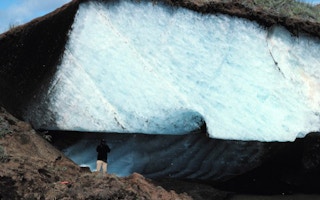Think of permafrost as a slush fund of so-far uncertain value. The levels of Arctic permafrost that thaw each year and freeze again are growing at depths of 1cm a year, but the carbon locked away in the soils is – so far – not being released at an accelerating rate.
This is good news for climate change worriers, but only for the time being. Bo Elberling of the Centre for Permafrost at the University of Copenhagen in Denmark and colleagues report in Nature Climate Change that the soggy summer soils of Greenland, Svalbard and Canada where they have taken samples are not releasing carbon dioxide at the rate some had feared.
But the results are based on preliminary research and they still have to work out why carbon release is so slow – and whether it will remain slow.
The “active permafrost” is a natural feature of sub-Arctic life: there is a shallow thaw each summer, plants flower, insects arrive, migrating birds follow the insects, grazing animals forage, predators seize a chance to fatten, and then winter returns with the shorter days.
But of all the climate zones, the Arctic is responding fastest to global warming, with a startling loss of sea ice; the glaciers, too, are in retreat almost everywhere.
Professor Elberling and colleagues have been taking measurements over the three or four months of the thaw for the last 12 years; they have also modelled changing conditions in the laboratory.
Slow decay rate
There they could change the drainage and control the temperature, and they found that a layer of thawing permafrost could lose significant quantities of carbon, as the microbes resumed the business of decay: in 70 years of such annual thaw and freeze, up to 77% of the soil carbon could turn into carbon dioxide, with serious consequences for yet further global warming.
But, they report in Nature Climate Change, that does not seem to be happening at any of the sites under test: if the water content of the thawing soils remains high, then carbon decay is very slow, and the eventual release of this carbon could take hundreds of years.
So anyone who wants to model this release will have to think about whether there is enough oxygen to speed up the release, or whether cold water will dampen the process and slow it down.
“It is thought-provoking that micro-organisms are behind the entire problem – micro-organisms which break down the carbon pool and which are apparently already present in the permafrost. One of the critical decisive factors – the water content – is in the same way linked to the original high content of ice in most permafrost samples.
“Yes, the temperature is increasing, and the permafrost is thawing, but it is, still, the characteristics of the permafrost which determine the long-term release of carbon dioxide,” says Elberling.










